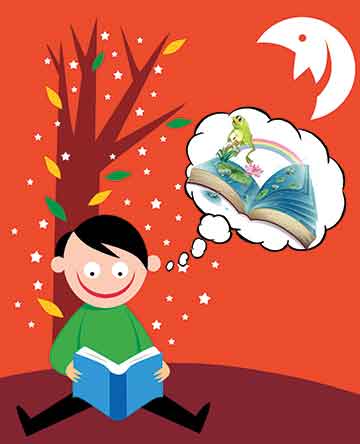Pradita Nambiar
During the recent parent-teacher meeting that I had at my preschool, a parent asked this question, “Why the emphasis on storytelling?” Amongst the many things that I have been trying to engage the parents with in the learning process is reading aloud stories to their children. We have started the practice of lending books to our children aged 3 to 6 for the weekend. We have requested parents to read stories to their children over the weekend. Children are slowly learning the art of borrowing books and returning them on Monday mornings in the same condition that they took them home in.
This simple act has brought a number of benefits for the entire community of parents, teachers, and children. Now my little children with missionary zeal are getting the parents back to their reading habits and away from the daily diet of television serials. Little do we realize that this act of reading stories to children brings better health and happiness in the lives of both parents and children. Little needs to be told of the bonding that develops between the storyteller and the listener.
 Another parent, “My child now wants a story told to her everyday. Where do I get so many stories from?” We have noticed that children like it more when stories are repeated. We all wonder why this happens. Well, children love it when they are able to predict what is going to happen next in the stories. The joy and confidence which exudes in their ability to predict the outcome is palpable for the teacher.
Another parent, “My child now wants a story told to her everyday. Where do I get so many stories from?” We have noticed that children like it more when stories are repeated. We all wonder why this happens. Well, children love it when they are able to predict what is going to happen next in the stories. The joy and confidence which exudes in their ability to predict the outcome is palpable for the teacher.
But the question the parent asked me sparked a thought, do I have to always rely on books for stories, can the children and I generate our own stories? I decided to dispel these doubts. I took the children out of the classroom and we sat under the yellow gulmohar tree. The teachers in my school were quite apprehensive as they believed that all learning (most of us believe teaching and learning are synonymous!) happened within the four walls of the classroom. Today, the shade under the tree was our space for learning.
The children warmed up to all the sights and sounds around them like the caw-caw of the crows, continuous squeals of the squirrels, the little ants roaming around on the ground that we sat and the rustling of the leaves with the breeze. How can I miss the sunlight streaming in through the shade! After soaking in the atmosphere, we decided to try and draw the tree under whose shade we were sitting. One child said she did not know how to draw a tree. Then I heard more voices say the same. So we started looking at the colours on the tree – the trunk, leaves, flower, and the pods. We also felt the texture of the bark, leaves and the pods. We then looked at other trees and slowly the feeling of ‘I do not know’ started dissolving. Now their books started filling up with mangoes, brinjals, cats, dolls, ‘my amma with long black hair’, house, sun and much more. We drew more than just trees, we drew the life around the trees.
We then decided to weave a story around their drawings. The drawings were arranged in a sequence and a new story was born. The children were the illustrators and the story writers. This was just one way of creating new stories that I stumbled upon. I know for sure that there are many more interesting ideas waiting out there for all of us to discover and to recreate the magic of stories.
Going back to the parent-teacher meeting, a parent said, “My child is a patient listener and listens to a number of stories in a day.” I was overjoyed to hear this and was curious to know who in the family was the storyteller. The parent unabashedly said, “TV”. We fail to realize that this method of using the electronic raconteur is very emotionally unsatisfying. This kind of storytelling kills the imagination of the children as everything is visual and children don’t learn to imagine pictures in their mind. Almost all stories come with loud music and sound effects which are far removed from real sounds. There is no narration or the scenes are so fast-paced that there is very little time for the child to comprehend the story in totality.
If we thought only children love to listen to stories, then we are fooling ourselves. Even today I’m all ears when my mother and mother-in-law share stories of their times. This art sure is a legacy that each one of us needs to celebrate and pass on to our children. I have realized that stories told don’t last just for the duration it is told, they have an everlasting effect.
The author is managing a preschool in Coimbatore. She can be reached at pradita_n@yahoo.com.
